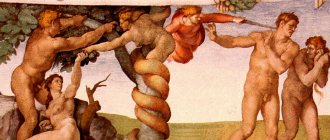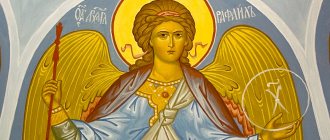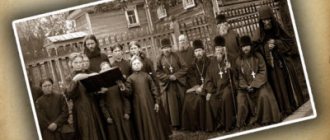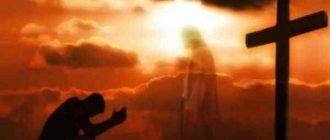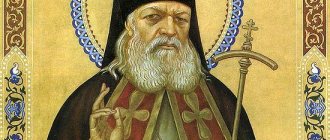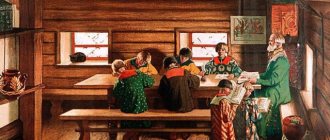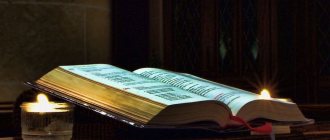The meaning of Veles among the Slavs
In the Rig Vedas, the Sacred Books of Knowledge, the glorified Volos is the guardian of lovers, the sower of prosperity, the connoisseur of talent. From the beginning of the World, Volos-Veles gave people animals, taught them to feed them, take milk from them, and raise them for meat, leather and wool.
He gave a pipe to shepherds and herd keepers and became their guard against wild animals. Having taught a man to harness animals to a plow and carts, Volos became a real mentor for the farmer. He is not only the guardian of a line of cattle on earth, but also the shepherd of his brother’s heavenly flock of cloud cows.
The confrontation between Perun and Veles is described in a myth: the thunder god Perun, who lives on the top of the mountain, in the sky, pursues his snake-like enemy, who lives below on the earth. The reasons for their discord are given differently - Veles’s abduction of cattle, people, and in some versions of the legend, the wife of the Thunderer.
The image of Veles underwent significant changes. He was considered the god of fertility, wealth and cattle breeding. Found in chronicles as the ruler of the underworld. Later mentioned as the patron of magicians, singers and art in general.
In Slavic pagan mythology, the deity appears in the form of the Serpent, the enemy of Perun. Veles the serpent, as a hypostasis of a broader archetype - Chernobog, embodies the forces of primeval Chaos, violent, unsettled, uninhabited nature, hostile to man.
Veles-Chernobog, possessing such a powerful destructive force, but also being the god of wisdom, knows how to keep Chaos in obedience and direct it in the right direction. But the evil principle of Veles began to dominate in human consciousness after the adoption of Christianity. Over time, having passed on his good traits to the Christian saints Nicholas and Blasius, Veles, like his animal forms - a snake, a goat, turned into the ruler of dark forces.
Researchers still do not know whether Volos is a form of the name Veles, or whether they are two different gods. Mansika claims that the first form is northern, and the second is southern, although no documentary evidence has been found for this. The word Veles comes from the Indo-European word *wel, which means
“to die”, or the Sanskrit
v'elaa
- time, from which it follows that this is the spirit of the ancestors, the ruler of the other world.
The name Volos is, of course, Slavic. There is a theory that it comes from the ancient Slavic word “vol”, that is, ox, but there is no exact data. G. M. Baratz argued that Volos is the Semitic Baal, the god of fertility, waters, sky and sun. Veles and Mansik are identified with Baal. This is primarily a “cattle god”, the patron of animals and wealth. Most likely, Volos and Veles were initially two different spirits, but over time they merged into one person.
Veles protects and replenishes the acquisitions inherited by the ancestors - land, livestock, house, wealth. The good God taught man not to kill animals, but to look after and use them. He patronizes them in forests and meadows. With its all-seeing eye, the spirit closely monitors the well-being of animals and birds.
Veles helped the good owner increase his wealth and harvest. Our ancestors believed that the beard of Volos reaches the earth, and in it, entwined with silk and silver-gold, is the “earthly draft”, the source of vegetation, life and all kinds of forces. For this, every owner revered him, leaving pinches of ears of corn at the end of the field during harvesting - “For Veles for his beard.”
And when the time came to drive the cattle out to pasture, people from everywhere walked along different paths to the abode of the deity along with herds of cattle to bless them and bring generous gifts. Veles is the patron saint of the Magi, poets who inspire with their strength. Anyone who knew how to compose songs and retell them to people was already a sorcerer. In short, the ancient clairvoyants and prophets were able to express the will, passion and desires dictated to them by the starry sky of their ancestors.
In songs, the Magi told about the glorious grandchildren of Veles, about their exploits, rituals and customs, they taught people to live righteously, to praise God, to respect the clan, to improve the soul through prayers and labor. They thank Veles for their skills in the construction of temples, buildings, and fortress walls. Songs, translations, rituals, holidays, dances, which were born from the kind soul of our grandfathers and great-grandfathers, were sent to them from heaven by Veles.
All poets, along with the glorious singer of the Russian land Boyan, about whom in the “Tale of Igor’s Campaign” it is written: “Prophetic Boyan, Volos’s grandson,” are the grandchildren of Veles. All of them were bearers and creators of the heroic epic of their native land.
Prayer to Saint Blaise for the health of cats
Blessed and ever-memorable Hieromartyr Blasius, wondrous sufferer and warm representative of ours, after your departure into eternal life, assist those who call on your holy name and promise to be heard in all petitions! Behold, now to you, the saint of God, as to the true intercessor of salvation, we come and humbly pray: come to our aid, bound by the bonds of sins, move to your all-powerful prayers to God and pray for us sinners: we dare to call you, unworthy, to intercede , and we wish to receive liberation from all our sins through you. Oh, Holy Blaise of God! In the contrition and humility of our hearts, we fall before you and pray: shine upon us, darkened by the slander of the enemy, with the light of grace from above, so that walking in it, we will not stumble our feet on a stone. You, as a vessel chosen in honor and filled with the grace of God, we pray: grant us sinners the desired acceptance from your fulfillment, and heal our mental and physical ulcers, and ask the Lord for forgiveness of our sins and for our mental and physical health, salvation that is beneficial, so that we may always glorify Father and Son and Holy Spirit, and your merciful intercession for our souls and bodies, now and ever and unto ages of ages. Amen.
Who and how revered the god Veles
This spirit received the greatest honor from the Trypillians when the earth was under the constellation Taurus. Sometimes his ancestry is traced to a shaggy bear, which is believed to influence successful hunting. In ancient times, there was a cult of the bear's paw, half-man, half-bear. Therefore, for hunters and trappers, the bear was a totem animal; it was appeased by the solemn offering of sacrifices.
For warriors, Volos, together with Perun, is the main god among the gods. Standing up to protect the land of their parents, Veles’s grandchildren took an oath:
We swear to the gods we believe in, Perun and Veles.
Volos himself plays all musical instruments wonderfully. Once, when a bloody battle rose beyond the “limit” between the glades and the Drevlyans, which even Perun with his lightning could not stop, Veles appeared with a pipe in his hands and played it so much, he charmed the warriors of both sides with heartfelt sadness that they lowered their swords and fraternized.
Since Veles was the deity of animals, prayers were offered to him for the protection of livestock. Therefore, shepherds were sometimes called “Veles”. He was also considered the guardian of hunters due to his ability to transform into a bear. Sometimes his name was given to the spirit of an animal killed during a hunt. In addition to the protector of animals, this deity had several other important functions. So, he “grazed” souls in the afterlife. In sources the name of the day of remembrance of the dead is found as the time of Veles. According to legend, then a ritual was carried out to burn animal bones.
Volos was revered in many places, but he was especially revered in the Novgorod, Kyiv and Rostov lands. Chronicles say that earlier his idol was erected on Podol. When the ancient Slavs entered into important deals, they called upon not only Perun, but also Volos to confirm their words. Previously, wealth was calculated by the number of livestock, so it is not surprising that it was so popular.
Tsaritsyn pagan temple
Prayer to Saint Blaise
Pets, just like people, have their own protectors; keep in mind that each type of animal has its own protector. Contacting the protectors will help heal your pet. They often pray to Saint Blaise in prayer for the health of the animal. During his lifetime, with the help of the holy word, he treated people and animals from serious illnesses.
People turn to him with requests to protect their pets from diseases. They ask him for the following:
If you see that something is wrong with your pet, then read a prayer to the saint, and he will definitely help you.
Having heard us from the villages of paradise where you live, Holy Hieromartyr Blasius, look upon us on earth, celebrating your holy memory with love. You asked the Lord for grace to heal those who are sick with the larynx, and also to heal animals and people from various ailments, as we read about this in your life. You yourself, Holy Hierarch, prayed to the Lord like this: “Lord, hear my prayers and, if in cattle, like a disease,
someone will happen and remember my name, saying: God, through the prayers of Thy servant Blasius, help him, O Lord, speed up help and healing for the glory and honor of Thy holy name!” Heal, O venerable Blasius, our illnesses and keep our livestock healthy, for all are creatures of God created by the One Creator. Look upon us graciously, Saint Blaise of God, for you have loved every creation on earth, as being called to be by God. Hearken to us, the worthy Blasius, because before your death you prayed to our Master and Lord 6 those who want to commemorate your memory, that they may be filled with the gifts of God and remain blessed. Hear, Hieromartyr Blasius, from us who honor your honorable memory, and pray to the Lord, who has promised to always fulfill your requests; May our homes abound in all kinds of blessings, and may our prayers for all needs be heard. You know, Saint Blaise, that, having everything he needs, a man of thanksgiving sighs to God and from contentment of spirit becomes kind and gentle. Do not reject us who pray to you, Saint Blaise, and be an intercessor for us before the Lord, so that we may live in prosperity and in all piety, and after our death we will be worthy to present ourselves without condemnation to the throne of the Savior Christ, glorifying Him with His Beginning Father and His life-giving Spirit forever. Amen.
Birth of Veles
The legend about the appearance of Veles is associated with the name of the ancient goddess Lada, the wife of Svarog, who could not give birth to a child. Then she asked the wise goddess of the Bereginya family for help. She advised Lada to go to Smetanoye Lake, which is located in Iria, to catch a magic fish, cook it in a special way and eat it. This was supposed to help Lada with her trouble.
And Veles’s wife Azovushka weaves a flying carpet for her husband.
Lada listened to Beregini’s advice. Having completed all the actions, she took the fish bones and took them away from the house. After some time, the Divine Cow grazed in the meadow where the scraps were left and accidentally ate them. A short time later, Lada delighted her husband with three daughters, future goddesses, and Zemun gave birth to Volos. He had the strange appearance of a half-man, half-bull, but from birth he possessed magic and knew how to give himself any appearance.
The deity is depicted in different ways, but there is still a certain established image. He usually appears as a handsome man with a long gray beard and hair. An owl always sits on his shoulder as a symbol of wisdom and peace. In the right hand there is a wooden staff, on the top of which a figure of a bear or the rune of Belobog is carved.
Why are brothers considered patrons of animals?
The veneration of holy martyrs as patrons of domestic animals, especially horses, arose already in the 13th century. Evidence of miraculous healings emanating from the relics of righteous martyrs was described by the Novgorod pilgrim Anthony already in 1200.
Since then, in Novgorod there has been a legend about stopping the death of livestock and healing animals through prayers to Flora and Laurus.
Hagiographic icon of the martyrs Florus and Laurus
Veles in Slavic mythology
All lower spirits obeyed him. Veles married Azovushka (the spirit of the Azov Sea (daughter of Svarog and Mother of the Earth). Buyan Island became the magical abode of Veles and Azovushka.
Veles was mainly concerned with earthly affairs, because he was revered as the lord of forests, animals, the god of poetry and prosperity. He was the moon god, the brother of the Sun and the Great Guardian of the Rule. According to Vedic teachings, after death, human souls rose along the moonbeam to the Navi gates. Here Veles meets souls. The pure souls of the righteous are reflected from the Moon and follow the sun’s ray to the Sun, the abode of the Almighty. Other souls either remain with Veles on the Moon and are purified, or are reincarnated on Earth as people or lower spirits. Veles is also the guardian and keeper of the Smorodina River, the Ra River and the Black Stone.
They sacrificed bulls and sheep to Veles. He embodied the power of gold. Hence the meaning of Svyatoslav’s oath is clear: “if they betray Perun, let them turn yellow like gold.” Perun and Veles not only coexisted in oaths, but also opposed each other: the first was the god of the squad, and the second the god of the rest of (non-military) Rus'. While the image of Perun was located in the upper, princely part of Kyiv, the statue of Veles stood below, on Podol, near the trading piers. Some properties and signs of the pagan Veles were later reflected in the Christian Blasius.
Prayer for the blessing of the flock
Master, Lord our God, who has power over all creatures, we pray to You, and we ask You, as You blessed and multiplied the flocks of the Patriarch Jacob,
A person’s attention to animals, concern for them, should in no case distract his moral consciousness from the most important commandment: “Love your neighbor as yourself” (Matthew 22:39).
After all, it very often happens that a person treats his loved ones and relatives poorly, and, on the contrary, treats his pets with love and affection - this indicates a false structure of the spiritual and moral life of this person. “Penetrate, beloved, into the intelligent essence of the soul; and don’t delve into it lightly. The immortal soul is a precious vessel. Look how great heaven and earth are, and God was not pleased about them, but only about you. Look at your dignity and nobility, because he did not send angels, but the Lord himself came as an intercessor for you, to call upon the lost, ulcerated, to return to you the original image of pure Adam.”
Miracle of Archangel Michael
The same legend formed the basis of the plot of the most famous icon dedicated to the martyrs, “The Miracle of Flora and Laurel.” The plot of the icon tells how the saints came to the rescue of a shepherd who had lost his horses and helped find the lost animals.
The icon depicts the Archangel Michael on a golden background, standing on the top of a hill, facing those praying, and on the sides are the passion-bearers Florus and Laurus. Below are two horses: white and black under beautiful saddles. Archangel Michael gives the brothers the reins of these horses.
